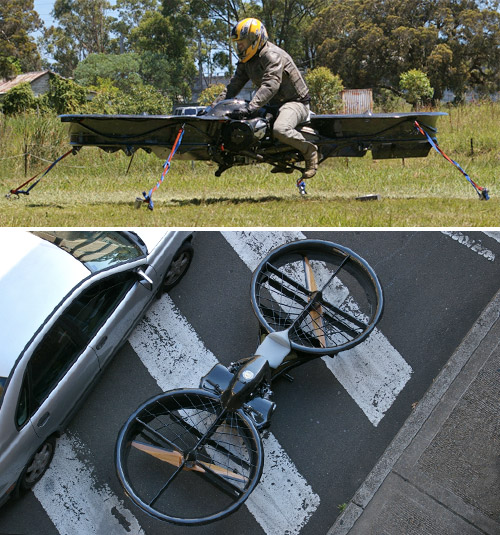
By Andrew Liszewski
The term ‘hoverbike’ makes me think of the exciting Speederbike chase through the forests of Endor in Return Of The Jedi. Sadly, that’s not quite the experience that Australian Chris Malloy’s Hoverbike offers. But it’s also only the first generation of the technology, so the potential is still there. Instead of hovering effortlessly off the ground using some manner of vague sounding science-fiction technology, Chris’ Hoverbike uses a set of front and back ducted propellers powered by a 1,170 cubic centimeter 4-stroke engine. Not only can it reach speeds of up to ~173 mph (150 knots) but also altitudes of up to 10,000 feet.
In theory that is, since the Hoverbike still only exists as a prototype that hasn’t undergone flight testing yet. But that’s because Chris needs to make sure it’s safe to fly. The frame is made from kevlar reinforced carbon fiber with a light foam core, so it seems as strong as current materials allow it to be. While the propeller blades are made of Tasmanian Oak with the leading edges covered in carbon fiber. And since there’s two of them spinning in opposite directions, there’s no need for a tail rotor to cancel out the rotational forces. It’s controlled not unlike a motorcycle, with a set of handlebars used for controlling direction, lift and speed, and its standard 30L fuel tank provides a flight range of ~92 miles at a speed of 80 knots.
Chris hopes to see the Hoverbike go into limited production in a year’s time, with a price tag of around $40,000 that should come down as production ramps up each year. And since it’s classified as an ultralite, it will be available to people without the need for a pilot’s license, increasing the market for interested buyers/thrillseekers.





wouldn’t it be more stable as a “quadro-copter” bike?
1 word…”scary”
— too Terminator said that it looks a bit dangerous 🙂
I want it. What kind of fuel would it burn though? and how is roll controlled?
Flying motorcycles?! Sweet, see ya suckers, I hope ya like sitting in traffic while I soar on by!
This thing is insane. Someone asked roll would be controlled? Answer: it wouldn’t! You’d have to have a deathwish to take this thing over 6 feet high.
You’d have to have a death wish to take this thing over 6 or 7 feet! There’s NO WAY this thing wouldn’t roll!
Surely, pitch is controlled the same way using electronic gyro’s as used in certain model vehicles. I bet this thing is one noisy fekker. If the single engine goes poop at altitude, you’ll be wanting a good parachute because it will not glide.
Is that a 1200cc BMW flat twin with front and back shaft drives I see before me? Who’d of thought to use such a lump!